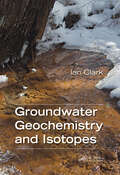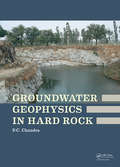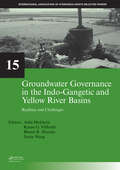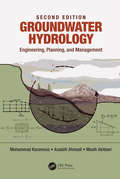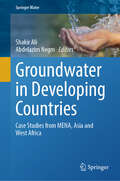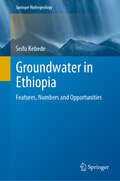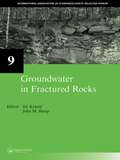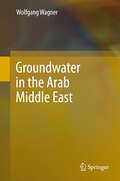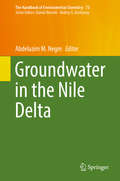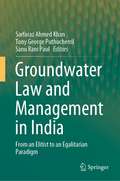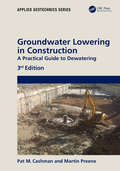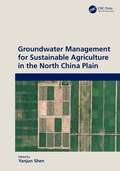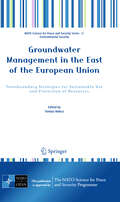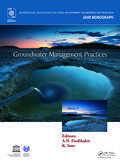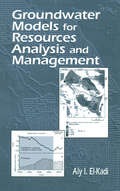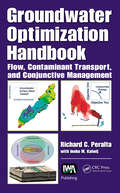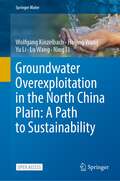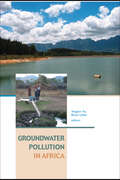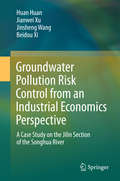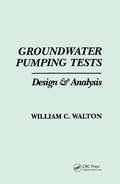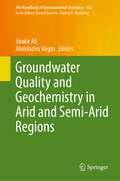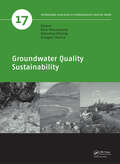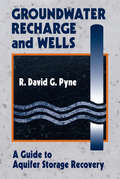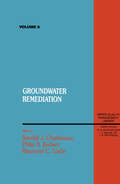- Table View
- List View
Groundwater Geochemistry and Isotopes
by Ian ClarkThere remains a lack of understanding of environmental isotopes and their use; students and practitioners typically find the concepts of isotope concentrations and partitioning to be more complicated than for geochemistry. However, this need not be so, if the basics are presented together with geochemistry, using case studies and examples to make the point. This new book presents the basics of environmental isotopes and geochemistry together, with case studies and simple examples that build a real understanding of their use in natural and contaminated groundwater.
Groundwater Geophysics in Hard Rock
by Prabhat Chandra ChandraIn hard rock terrain, shallow water wells generally have a poor to moderate yield. Sinking wells deeply to tap yielding fracture zones often backfires, because the borehole may miss the saturated fracture zones at depths. A wrong approach to groundwater exploration in hard rock has therefore often led to unnecessary recurring expenditures and waste
Groundwater Governance in the Indo-Gangetic and Yellow River Basins: Realities and Challenges (IAH - Selected Papers on Hydrogeology)
by Aditi Mukherji Karen G. Villholth Bharat R. Sharma Jinxia WangOne of the key features of agricultural development in the last five decades has been intensive groundwater use in the Indo-Gangetic Basin (Pakistan, India, Nepal and Bangladesh) and in the Yellow River Basin (China). Groundwater irrigates almost 60% of the net irrigated area in South Asia and 70% in the north China plains. Groundwater use for agri
Groundwater Hydrology: Engineering, Planning, and Management
by Mohammad Karamouz Azadeh Ahmadi Masih AkhbariIncreasing demand for water, higher standards of living, depletion of resources of acceptable quality, and excessive water pollution due to urban, agricultural, and industrial expansions have caused intense environmental, social, economic, and political predicaments. More frequent and severe floods and droughts have changed the resiliency and ability of water infrastructure systems to operate and provide services to the public. These concerns and issues have also changed the way we plan and manage our surface and groundwater resources. Groundwater Hydrology: Engineering, Planning, and Management, Second Edition presents a compilation of the state-of-the-art subjects and techniques in the education and practice of groundwater and describes them in a systematic and integrated fashion useful for undergraduate and graduate students and practitioners. This new edition features updated materials, computer codes, and case studies throughout. Features: Discusses groundwater hydrology, hydraulics, and basic laws of groundwater movement Describes environmental water quality issues related to groundwater, aquifer restoration, and remediation techniques, as well as the impacts of climate change \ Examines the details of groundwater modeling and simulation of conceptual models Applies systems analysis techniques in groundwater planning and management Delineates the modeling and downscaling of climate change impacts on groundwater under the latest IPCC climate scenarios Written for students as well as practicing water resource engineers, the book develops a system view of groundwater fundamentals and model-making techniques through the application of science, engineering, planning, and management principles. It discusses the classical issues in groundwater hydrology and hydraulics followed by coverage of water quality issues. It also introduces basic tools and decision-making techniques for future groundwater development activities, taking into account regional sustainability issues. The combined coverage of engineering and planning tools and techniques, as well as specific challenges for restoration and remediation of polluted aquifers sets this book apart.
Groundwater in Developing Countries: Case Studies from MENA, Asia and West Africa (Springer Water)
by Shakir Ali Abdelazim NegmThis book comprehensively discusses different scientific approaches, including groundwater sustainability, numerical modeling, index approach, isotope hydrology, environmental Isotopes, and advanced GRACE satellite data from different regions in developing countries globally, to help understand the groundwater system for strategic management of freshwater resources. This would help estimate an accepted logistic framework that might help control, and evaluate the significance of predicted climatic and anthropogenic impacts on groundwater resources. The book presents and discusses unique case studies from Asia (Turkey, Afghanistan, and Kyrgyzstan), MENA (Middle East and North Africa), particularly focussing on Algeria, Egypt New Delta, and KSA and West Africa (Nigeria) and has chapters covering most of the other MENA countries. The book presents a comprehensive investigation of the methods employed for groundwater utilization, with a dual focus on elucidating existing issues and confronting contemporary challenges. The findings are significant as they provide a deeper understanding of the complex issues surrounding groundwater utilization. Approaches for enhancing and rationalizing water extraction from Saharan aquifers are discussed to promote regional advancement and preserve long-term sustainability. The book will be of great help to numerous researchers and academicians, and will be an important account for stakeholders.
Groundwater in Ethiopia
by Seifu KebedeThis book provides a comprehensive description of groundwater resources in Ethiopia and its various dimensions (groundwater as resource, environmental functions, and socioeconomics). The prevailing knowledge of groundwater resources in Ethiopia (or elsewhere in Sub Saharan Africa) was based on geological and stratigraphic framework known nearly four decades ago (mainly 1960's and 70's). Thanks to the substantial geoscientific research since the 70's a new set of relevant geological/stratigrahpic data has been created that helps to re-define our understanding of groundwater resources in Africa as a whole and in Ethiopia in particular: a) For the first time the basement aquifer of Ethiopia has been described hydrogeologically based on genesis of regoliths (deep weathering and striping history); clear regional difference in groundwater potential is shown for the first time; comparative accounty has been given regarding groundwater occurrence in the generally low grade basement rocks of Ethiopia (Arabian Nubian shield) and high grade basement rocks of the rest of Africa. b) For the first time groundwater occurrence in multilayred sedimentary rocks account for spatial variation in degree of karstification; deformation history, and stratigraphy. c) The vast volcanic aquifers of Ethiopia which have previously classified based on their ages are now reclassified based on age, morphology (eg. groundwater in plateau volcanics, groundwater in shield volcanics) and aquifer structure. d) The loose alluvio lacustrine sediments which were known as least extensive in previous works based on areal cover are in fact shown to host the most voluminous groundwater resources in Ethiopia. These aquifers have now been described based on their geomorphology, extent, and genesis. The aim of this book is to use these newly created knowledge to redefine the understanding of groundwater resources in Ethiopia.
Groundwater in Ethiopia: Features, Numbers and Opportunities (Springer Hydrogeology)
by Seifu KebedeThis book provides a comprehensive description of groundwater resources in Ethiopia and its various dimensions (groundwater as resource, environmental functions, and socioeconomics). The prevailing knowledge of groundwater resources in Ethiopia (or elsewhere in Sub Saharan Africa) was based on geological and stratigraphic framework known nearly four decades ago (mainly 1960's and 70's). Thanks to the substantial geoscientific research since the 70's a new set of relevant geological/stratigrahpic data has been created that helps to re-define our understanding of groundwater resources in Africa as a whole and in Ethiopia in particular: a) For the first time the basement aquifer of Ethiopia has been described hydrogeologically based on genesis of regoliths (deep weathering and striping history); clear regional difference in groundwater potential is shown for the first time; comparative accounty has been given regarding groundwater occurrence in the generally low grade basement rocks of Ethiopia (Arabian Nubian shield) and high grade basement rocks of the rest of Africa. b) For the first time groundwater occurrence in multilayred sedimentary rocks account for spatial variation in degree of karstification; deformation history, and stratigraphy. c) The vast volcanic aquifers of Ethiopia which have previously classified based on their ages are now reclassified based on age, morphology (eg. groundwater in plateau volcanics, groundwater in shield volcanics) and aquifer structure. d) The loose alluvio lacustrine sediments which were known as least extensive in previous works based on areal cover are in fact shown to host the most voluminous groundwater resources in Ethiopia. These aquifers have now been described based on their geomorphology, extent, and genesis. The aim of this book is to use these newly created knowledge to redefine the understanding of groundwater resources in Ethiopia.
Groundwater in Fractured Rocks: IAH Selected Paper Series, volume 9
by Jiří Krásný John M. Sharp Jr.The hydrogeologic environment of fractured rocks represents vital natural systems, examples of which occur on every continent. This book discusses key issues, methodologies and techniques in the hydrogeology of fractured rocks, summarizing recent progress and anticipating the outcome of future investigations. Forty-four revised and updated papers w
Groundwater in the Arab Middle East
by Wolfgang WagnerThe book gives an outline of prevailing hydrogeologic conditions in the Arab Middle East together with the geologic background. Emphasis is given to relationships between the main features influencing the hydrogeologic conditions - regional geologic developments, paleogeographic conditions, morphology, climate and paleo-climate - and the resulting hydrogeologic features: formation of aquifers, distribution of major aquifers, main groundwater flow systems, occurrence of renewable and fossil groundwater. Reported data on hydraulic aquifer parameters, recharge rates and groundwater flow volumes are evaluated with a view to arrive at characteristic values under the specific hydrogeologic and climatic conditions. The area considered covers approximately the Arabian Plate. Information on the following countries is included: Bahrain, Iraq, Jordan, Kuwait, Lebanon, Oman, Qatar, Saudi Arabia, Syria, United Arab Emirates, West Bank and Gaza, Yemen.
Groundwater in the Nile Delta (The Handbook of Environmental Chemistry #73)
by Abdelazim M. NegmThis unique volume offers an up-to-date overview of all the main aspects of groundwater in the Nile Delta and its fringes, as well as latest research findings. The themes covered include: · Nile Delta aquifer formation and its characteristics · The use of the groundwater in the Nile Delta and its implications · Sedimentology and hydrogeophysical characteristics · Groundwater investigations and aquifer characterization using current direct resistivity and induced polarization · Groundwater contamination and degradation · Saltwater intrusion and its control · Delineation of groundwater flow and seawater intrusion using various techniques, including one-dimensional subsurface temperature profiles, geoelectrical resistivity, and integrated subsurface thermal regime and hydrogeochemical data · Modeling of groundwater and of saltwater intrusion in the Nile Delta aquifer · Excessive pumping and groundwater quality assessment for irrigation and drinking purposes · Groundwater management for sustainability in the Nile Delta. The volume appeals to postgraduate students, researchers, scientists, professionals, decision makers and planners.
Groundwater Law and Management in India: From an Elitist to an Egalitarian Paradigm
by Sarfaraz Ahmed Khan Tony George Puthucherril Sanu Rani PaulThis book presents a comprehensive analysis of the existing nature of India’s groundwater laws. In the backdrop of the gravity of groundwater crisis that threatens to engulf the country, the book examines the correlation between the imperfections in the law and water crisis and advocates a reform agenda to overhaul the legal framework. It accomplishes this objective by examining how some of the States and Union Territories regulate and manage groundwater through the legal instrumentality against the backdrop of the two conflicting paradigms: the “elitist” and the “egalitarian.” The book’s fundamental premise is that despite being an extraordinarily critical resource that supports India’s burgeoning population’s ever-increasing water demands, groundwater is abused and mismanaged. The key argument that it posits is that the elitist paradigm must give way to an egalitarian one where groundwater is treated as a common property resource. To place this message in perspective, the book’s introduction explains the dichotomy between the two paradigms in the context of groundwater. This sets the stage, after which the book is divided thematically into three parts. The first part deals with some of the general groundwater management concerns brought to the fore by the operation of the elitist paradigm. Since water is constitutionally a State subject, the second part analyses the groundwater legislations of different States and Union Territories set against their unique circumstances. As these laws do not dismantle the elitist paradigm that interlocks groundwater rights to land rights, the next part articulates the legal reform agenda where a case is made to re-engineer groundwater laws to reflect a more sustainable basis. The findings and arguments resonate with the situation in many developing countries around the world due to which the book is a valuable resource for researchers across disciplines studying this area, and also for policy makers, think tanks, and NGOs.Groundwater Management–Inter-state Water Conflicts–Aquifers–Water Markets–Water Security–Water Law Reform–Groundwater Law–Water Law–Sustainable Development–Hydrology
Groundwater Lowering in Construction: A Practical Guide to Dewatering
by Pat M. Cashman Martin PreenePraise for the Second Edition: "This is the book that the dewatering sector really needs – it is reliably based on sound theory and profound understanding of the physical processes, yet is presented in a very accessible and user-friendly manner. It draws on many, many decades of experience, and yet is utterly up to date. . . . It is a one-stop shop for the dewatering practitioner – who can nonetheless rest assured that the theoretical basis of the methods presented is flawless."— Professor Paul L. Younger, FGS, FICE, C.Geol., C.Eng., FREng, University of Glasgow, Scotland, UK "The best reference on this topic available . . . and will prove useful to a wide variety of readers ranging from junior construction engineers or dewatering contractors to theoretical hydrogeologists and environmental managers. It is rare that a book is able to bridge the gap between theoretical design guidance and practical application." — S.N. Sterling, University of Waterloo, Canada The extensively updated Groundwater Lowering in Construction: A Practical Guide to Dewatering, 3rd Edition offers practical advice on all phases of groundwater control systems, from planning and design, through installation and maintenance, and ultimately decommissioning. The expertise provided in this book can help you improve working conditions, increase project viability, save time and reduce excavation costs. Designers and managers of construction and engineering projects are given the tools necessary to effectively control groundwater. The content is divided into three sections – Principles, Design and Construction. The Principles section explains the fundamentals of groundwater flow as it relates to civil engineering excavations. The Design section explores in extensive detail site investigation, permeability assessment methods and groundwater control strategies. Chapters in the Construction section describe dewatering and exclusion techniques, and examine the complete life cycle of a groundwater control scheme, including monitoring, maintenance and decommissioning. This section incorporates eleven case histories from the authors’ casebook. The 3rd edition has been greatly revised and updated, and contains more than 200 new illustrations. The new content covers: Permeability of soils and rocks Groundwater problems for excavations in rock Groundwater control for tunnelling projects, such as shafts and cross passages Methods for assessing permeability Decommissioning of dewatering systems Optimisation of groundwater control schemes. The new, expanded content offers valuable direction that can give you a true competitive advantage in the planning and execution of temporary and permanent dewatering works for excavation and tunnelling. Written for practising engineers, geologists and construction managers, as well as postgraduate engineering students, this revamped manual on design and practice presents numerous case studies and extensive references to enhance understanding. Martin Preene is a groundwater consultant, based in the UK. He has more than 30 years’ experience working on dewatering and groundwater control projects worldwide.The late Pat Cashman was the leading British exponent of groundwater control for his generation, championing a practical and straightforward approach for more than forty years.
Groundwater Management for Sustainable Agriculture in the North China Plain
by Yanjun ShenThis book is a unique text that explores recent research on the management of sustainable groundwater use in the North China Plain (NCP), where aquifers are suffering the most severe over‑pumping in the world and have caused serious ecological degradation. It contains research conducted by the editor and his teams on several projects over the past 18 years.Key topics covered include: comprehensive scheme and pathways to achieve sustainable groundwater management description of theoretical basis for water saving and technologies developed in practice at field scale adjusting cropping patterns and planting structure to reduce the cultivation intensity to a suitable extent soft measures such as water metering, pricing, and water marketing being applied in groundwater management practice in the NCP. It will be an invaluable resource to graduate students, education and research staff, and agriculture or water resources authorities.
Groundwater Management in the East of the European Union
by Tomasz NaleczThis volume is the result of work carried out under the NATO SPS Study Pilot Project "Sustainable Use and Protection of Groundwater Resources - Transboundary Water Management." It contains basic information on hydrogeological conditions, groundwater management and monitoring in areas of the Belarus, Lithuanian, Polish and Ukrainian borders, simultaneously borders of the European Union with its eastern partners. In view of the importance of the rational utilization of groundwater reserves, which is essential for our future existence, the book presents recommendations for a united methodology of an integrated groundwater monitoring system in this transnational area. The contributions also cover environmental and surface water issues that have direct effects on groundwater resources. The financial dimension of resource mobilization for environmental projects in Eastern Europe also features as part of a complex project solution.
Groundwater Management Practices (IAHR Monographs)
by Angelos N. Findikakis Kuniaki SatoThe book presents and compares practices followed in various different countries for the development, protection and management of groundwater resources. It includes overviews of technical and non-technical aspects of groundwater management practices and selected case studies in different countries. Further it provides reviews of specific technical issues such as groundwater quality management and protection, groundwater impacts of underground structures and hazards of artificial recharge and discharge; discussions of regulatory and legal issues affecting groundwater management.
Groundwater Models for Resources Analysis and Management
by Aly I. El-KadiWritten by renowned experts in the field, this book assesses the status of groundwater models and defines models and modeling needs in the 21st century. It reviews the state of the art in model development and application in regional groundwater management, unsaturated flow/multiphase flow and transport, island modeling, biological and virus transport, and fracture flow. Both deterministic and stochastic aspects of unsaturated flow and transport are covered. The book also introduces a unique assessment of models as analysis and management tools for groundwater resources. Topics covered include model vs. data uncertainty, accuracy of the dispersion/convection equation, protocols for model testing and validation, post-audit studies, and applying models to karst aquifers.
Groundwater Optimization Handbook: Flow, Contaminant Transport, and Conjunctive Management
by Richard C. PeraltaExisting and impending water shortages argue for improving water quantity and quality management. Groundwater Optimization Handbook: Flow, Contaminant Transport, and Conjunctive Management helps you formulate and solve groundwater optimization problems to ensure sustainable supplies of adequate quality and quantity. It shows you how to more effecti
Groundwater overexploitation in the North China Plain: A path to sustainability (Springer Water)
by Wolfgang Kinzelbach Haijing Wang Yu Li Lu Wang Ning LiOver-pumping of aquifers is a worldwide problem, mainly caused by agricultural water use. Among its consequences are the falling dry of streams and wetlands, soil subsidence, die-off of phreatophytic vegetation, saline water intrusion, increased pumping cost and loss of storage needed for drought relief. Stopping or reversing the trend requires management interventions. The North China Plain serves as an example. A management system is set up for a typical county. It contains three components: monitoring, decision support based on modelling, and implementation in the field. Besides all monitoring data, the decision support module contains an irrigation calculator, a box model, and a distributed groundwater model to project the outcomes of different water allocation scenarios. In view of grain security, a solution combines an adaptation of the cropping system with imports of surface water from the South. The Open Access book does not only describe the problem and the path to its solution. It also gives access to nine manuals concerning methods used. They include computer programs and the game Save the Water. The Chinese experience should be of considerable interest to other regions in the world which suffer from over-pumping of aquifers.
Groundwater Pollution in Africa
by Yongxin Xu Brent UsherIn 2000, various UN organizations launched a collaborative effort to assess the vulnerability of groundwater in several African cities. The project addressed the issue of aquifer vulnerability and the protection of groundwater quality. This book is a collection of thirty peer-reviewed papers on the topic, and provides a glimpse of the situation acr
Groundwater Pollution Risk Control from an Industrial Economics Perspective: A Case Study On The Jilin Section Of The Songhua River (SpringerBriefs in Environmental Science)
by Beidou Xi Jinsheng Wang Jianwei Xu Huan HuanThis book argues that groundwater pollution risk assessment is the essential foundation of groundwater pollution prevention and control. It is on this basis that economic leverage is used to make new breakthroughs in groundwater protection and governance. Presenting a case study on the Jilin Section of the Songhua River, the book applies the overlay index method to assess the shallow groundwater pollution risk and identify high-risk areas and major pollution sources in an effort to identify the mechanism of interaction between industrial structures and groundwater pollution. Further, it proposes concrete measures for preventing and controlling groundwater pollution from an industrial economics perspective. As such, the book offers a valuable resource for all graduate students, lecturers and researchers who are interested in learning about resources and environmental economics.
Groundwater Pumping Tests
by William C. WaltonThis practical book 'Groundwarer Pumping Tests', details concepts, techniques, field work, case studies, and microcomputer models-information designed to improve accuracy and reliability. The reader is expected to have a working knowledge of hydrogeology or access to books on groundwater geology and hydrology. Too frequently, groundwater pumping test design and analysis ignore well storage capacity, delayed gravity yield, well partial penetration, and aquitard storativity impacts without proving them negligible. As a result, erroneous conclusions are reached concerning aquifer system hydraulic characteristics, boundaries, and discontinuities. Pumping test data often is filtered arbitrarily without adequate justification in attempts to match inappropriate aquifer models and field conditions. Antecedent water level trends and water level adjustments for changes in barometric pressure and surface water stages frequently are ignored in calculating drawdown and recovery. Finally, manual graphic analysis supplemented with microcomputer programs is, to an excessive extent, being replaced by fully automatic microcomputer analysis without critical examination of interpretative methods in program algorithms and their limitations. This book will focus needed attention on the facets mentioned above.
Groundwater Quality and Geochemistry in Arid and Semi-Arid Regions (The Handbook of Environmental Chemistry #126)
by Shakir Ali Abdelazim NegmThis book reviews groundwater quality and its major global contaminants, and collects the latest advances in the analysis, remediation, risk assessment, and hydrogeochemistry of groundwater in countries such as Algeria, Egypt, Ghana, Kazakhstan, Morocco, Saudi Arabia, and the USA. This book mainly focuses on the major arid and semi-arid areas where groundwater is scarce and highly polluted with geogenic and anthropogenic contaminants and the recharge to the groundwater is negligible due to limited rainfall. Divided into 2 parts, the book starts by covering topics like assessment and protection of groundwater in arid and semi-arid regions, groundwater pollution, and contamination risk assessment. Particular attention is given to the application of environmental isotopes in groundwater studies and how anthropogenic activities impact groundwater quality, the impact of irrigation reservoirs in groundwater and soil quality, and how artificial intelligence is applied to forecast groundwater quality. In the second part of this book, readers will find more about the major global contaminants of groundwater in arid and semi-arid areas, including a geochemical analysis of fluoride and nitrate contamination. Supported by regional case studies, this book appeals to researchers, scholars, and professionals working in the field of groundwater contamination and remediation and is also an important account for policymakers.
Groundwater Quality Sustainability (IAH - Selected Papers on Hydrogeology)
by Piotr Maloszewski Stanisław Witczak and Grzegorz MalinaSustainable groundwater development requires knowledge of the appropriate recharge and transport-processes. This is a prerequisite to understanding: (i) groundwater resources and their availability, and (ii) the dependence between groundwater and the environment. Conceptual understanding of groundwater flow at both temporal and spatial sc
Groundwater Recharge and Wells: A Guide to Aquifer Storage Recovery
by R. David PyneUnderstanding the issues that have been encountered at other sites, and the steps that have led to successful resolution of these issues, can provide great help to those considering, planning, or implementing new groundwater recharge projects. Recent technical advances and operational experience have demonstrated that well recharge is a feasible and cost effective method of artificially recharging natural aquifers. This practical guide reviews the technical constraints and issues that have been addressed and resolved through research and experience at many sites. The book presents aquifer storage recovery (ASR) technology and traces its evolution over the past 25 years in the United States. Procedures for groundwater recharge are presented, and selected case studies are examined. Drinking water quality standards and conversion factors are provided in the appendix for easy reference.
Groundwater Remediation, Volume VIII
by R.J CharbeneauThis book reviews the sources of soil and groundwater contamination and the potential remediation technologies. It focuses on remediation technologies that are commonly utilized in practice, and discusses a number of innovative technologies that show promise for special problem circumstances.
